Here it is: my third annual look back at the year’s literary output. I was unable to be as thorough as I am with my Year in Horror film overview, in which I endeavor to see and review as many of the year’s horror movies as I possibly can. Here I’ve had to specialize, meaning fans of David Wellington, Joe Lansdale, Bentley Little, Ray Garton and Dean Koontz fans will be disappointed, as all had new books out in 2008 that I missed.
So too the year’s Stephen King offerings DUMA KEY and JUST AFTER SUNSET (books I believe will sell just fine with or without my help). What I’ve endeavored to do below is point out lesser-known titles like Ron Dakron’s MANTIDS and Jeani Rector’s OPEN GRAVE. Never heard of those? Good! It’s my hope that the following will help acquaint many of you with worthy books and authors you might not already be aware of.
That doesn’t mean I’ve neglected the big names entirely. I couldn’t help but give old favorites like Jack Ketchum, J.G. Ballard, Richard Matheson and Alejandro Jodorowsky a shout out, especially since all put out work that’s well deserving of my praise.
As to the overall quality of 2008’s literary offerings, I’ll have to say it was better than the previous year’s. There were some disappointments (Blatty’s ELSEWHERE foremost among them) but for the most part I was pleased with what I read. On the other hand, there was nothing in ‘08 that got me jumping-up-and-down excited the way Norman Partridge’s DARK HARVEST and Joe Hill’s 20th CENTURY GHOSTS did in previous years.
So let’s get started. First up are the seasoned pros, who graced us with several must-reads, beginning with my favorite book of last year.
New Books by Old Masters
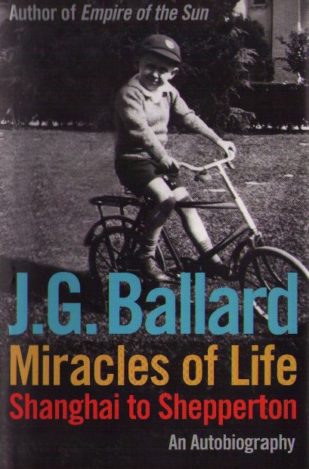 I’m always up for a new book from the incomparable J.G. BALLARD. His latest release, MIRACLES OF LIFE (Fourth Estate), is an autobiography. It’s also quite possibly the last book he’ll ever write, as in June 2006 Ballard learned he had advanced prostate cancer. What emerged is the most kind-hearted work this famously unsentimental author has ever written, a frank and straightforward yet affectionate glance back at an unusually eventful life. The demons that once drove J.G. Ballard seem to have been soundly put to rest, and nor does he appear to bear any grudges for the misfortunes he’s suffered.
I’m always up for a new book from the incomparable J.G. BALLARD. His latest release, MIRACLES OF LIFE (Fourth Estate), is an autobiography. It’s also quite possibly the last book he’ll ever write, as in June 2006 Ballard learned he had advanced prostate cancer. What emerged is the most kind-hearted work this famously unsentimental author has ever written, a frank and straightforward yet affectionate glance back at an unusually eventful life. The demons that once drove J.G. Ballard seem to have been soundly put to rest, and nor does he appear to bear any grudges for the misfortunes he’s suffered.
Those misfortunes began at age twelve, when Ballard, living in Shanghai with his British expatriate parents, was interned in a Japanese prison camp from March 1943 to June 1945. We get an effective overview of Ballard’s years in the Lunghua camp, where despite less-than-ideal living conditions the young Ballard “thrived,” finding life there exciting and enjoyable: “Lunghua camp may have been a prison of a kind, but it was a prison where I found freedom.” His teenage discovery of Freud and surrealist art further impacted Ballard a great deal, as anyone who’s read his fiction can readily attest.
Tragedy struck again in 1963, when Ballard’s wife Mary developed severe pneumonia and died suddenly. Ballard was left with the not inconsiderable chore of raising three rambunctious children on his own, although he claims those years were “the richest and happiest I have ever known”.
Curiously, Ballard doesn’t discuss his novels much outside CRASH and EMPIRE OF THE SUN. He does, however, give us tidbits on Steven Spielberg’s big budget movie adaptation of EMPIRE, on which Ballard is surprisingly positive, and David Cronenberg’s decidedly less mainstream filming of CRASH, which set off a veritable firestorm of controversy in England. Overall I feel MIRACLES OF LIFE is as wise, witty and warm a memoir as just about any you’ll find, an essential read for Ballard novices and superfans alike.
The Japanese KOJI SUZUKI is another essential author, and Vertical put out a new Suzuki novel in ’08: PROMENADE OF THE GODS. It’s something of a departure from the author of THE RING and its sequels, being a non-supernatural mystery. Still, this book, originally published in Japanese, does contain many RING-esque themes, including an average joe becoming an amateur sleuth to solve a bizarre mystery and a villainous personage who figured briefly in the RING books.
That personage is a guru called Kageyama, who runs a shadowy religious cult. It seems the seemingly mild-mannered Matsuoka has joined the cult after abruptly vanishing one day—but that’s only a surmise on the part of Matsuoka’s best friend Shirow, who does his best to puzzle out the possible details of his friend’s disappearance, and romances Matsuoka’s estranged wife in the process. Being the extremely meticulous writer he is Suzuki gives us far more information on that romance than is probably necessary, making for a somewhat lopsided account. But for the most part the book is a grabber, with an ingeniously worked-out narrative that never takes an expected turn, and a stunner of a climax.
The real problem is, like all Suzuki’s books in English, with the translation, which is done in drawn-out kid book fashion. A lot of the problem was clearly with the Japanese original, as is evident in the way Suzuki constantly rehashes the details of his story as one might for a slow or inattentive readership. Perhaps this is part and parcel for Eastern literature, but this Western reader found the paint-by-numbers prose a mite tiresome.
I wasn’t too enthusiastic about ELSEWHERE (Cemetery Dance) by the great WILLIAM PETER 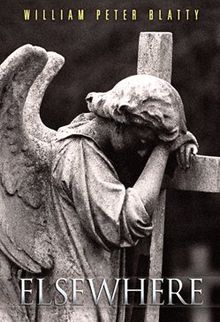 BLATTY, of THE EXORCIST and LEGION. Those books are all-time classics. This one is not.
BLATTY, of THE EXORCIST and LEGION. Those books are all-time classics. This one is not.
ELSEWHERE isn’t the “new” book it was advertised as, since it first saw print in the Al Sarrantonio edited 1999 anthology 999. For the most part it’s a low-key haunted house tale that’s more interesting than scary.
We meet Joan Freeboard, a NYC realtor trying to sell an allegedly haunted house. There’s also Anna Trawley, a psychic, and Dr. Gabriel Case, a world renowned authority on the paranormal. Freeboard arranges for the three of them to spend a few nights in the haunted house, along with Terry Dare, a Pulitzer Prize winning writer who will pen an article about their stay. Freeboard’s presumption is that nothing out of the ordinary will occur, and Dare’s article will reflect that. Yet upon settling in the four realize that something is clearly going on within the place. Noteworthy happenings include Freeboard’s frequent spells of Déjà vu, much noisy pounding and strange voices, and a (seemingly) ghostly priest who has a tendency to abruptly appear and then vanish. Throughout it all Case makes the others suspicious, as he has a strange air about him, almost as if he’s withholding some pertinent knowledge.
Clearly this is all leading up to something. The problem is the third act twist so integral to the story is far from unique. It might have been back 1999, but since then at least two popular movies have utilized variants on ELSEWHERE’S surprise ending. This blunts the impact considerably, and makes it far easier to spot the twist coming in advance.
JACK KETCHUM gave us a new book in 2008 called OLD FLAMES, published as a mass market paperback by the good folk at Leisure. It’s an unsparing peek into the hopeless life of Dora, a tough and aggressive high society gal who’s had terrible luck with men. After being dumped by yet another guy she decides to track down the whereabouts of her first-ever love Jim, who she dated in high school–and who broke her heart. Dora finds Jim living in Los Angeles with his wife of 20 years and two children, an existence Dora always wanted for herself. Jim’s wife Karen appears to be the only thing standing in the way of Dora’s dreams…but not for long!
This novella represents Ketchum in prime form. Penned in his usual pared-down style, it contains some strong and disturbing brutality, but also an entirely convincing story bolstered by spot-on character development. Dora is a pretty sympathetic character for the most part, and her obsessive behavior initially seems harmless and even somewhat understandable. Thus her inevitable descent into psychosis comes as something of a shock to us, just as it does to Dora herself. The narrative arc is as grim as can be imagined, culminating in a true shocker of a climax.
The Leisure edition of this book comes packaged with Ketchum’s 1998 novella RIGHT TO LIFE, about a pregnant woman kidnapped by a pair of anti-abortion loons and tortured in ways I won’t go into here. It’s about as rough as anything Ketchum has written, and as riotously compelling. Together these novellas make for a one-two punch of scalding horror of a type that only Jack Ketchum can deliver.
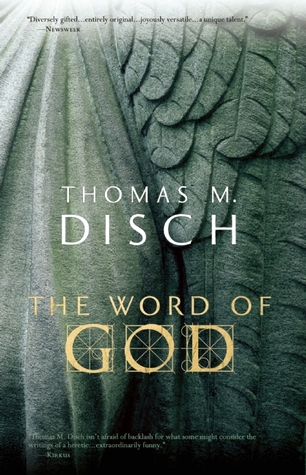 Finally we have THE WORD OF GOD by the late THOMAS M. DISCH (Tachyon). It was the first novel in a decade by the brilliant, confounding Disch, who tragically committed suicide shortly before its publication. Suicide is a theme that runs through the text of THE WORD OF GOD, at once an eccentric autobiography, a sustained religious argument and a bad joke. Much of it, I believe, is total nonsense, but there are also passages of brilliance fully suited to a writer of Disch’s talents.
Finally we have THE WORD OF GOD by the late THOMAS M. DISCH (Tachyon). It was the first novel in a decade by the brilliant, confounding Disch, who tragically committed suicide shortly before its publication. Suicide is a theme that runs through the text of THE WORD OF GOD, at once an eccentric autobiography, a sustained religious argument and a bad joke. Much of it, I believe, is total nonsense, but there are also passages of brilliance fully suited to a writer of Disch’s talents.
The subject is Disch himself, and his ascent to literal godhood. As such Disch expounds on the nature of faith and divinity, with several short stories illustrating his claims. The point of view is sarcastic and curmudgeonly, fully befitting Disch’s infamously cranky public persona.
Another subject is the late Philip K. Dick, who Disch identifies as his nemesis. In the late 1960s PKD, during a period of drug-induced mental illness, reported Disch to the FBI, an act Disch evidently never forgave. Several interrelated chapters relate how PKD escapes from Hell to assassinate Thomas Mann, apparently the illegitimate father of one Thomas M. Disch—in this way PKD can ensure Disch will never be born. Not to worry, though, as, being God, Disch has the power to thwart PKD’s dastardly plot.
I don’t know that I enjoyed THE WORD OF GOD all that much, but I have to give it points for audacity. Thomas Disch was never an especially commercial or prolific writer, but he was a vital talent who, as this book testifies, could always be counted on for the unexpected.
Fun with Santa Claus
SANTA CLAUS CONQUERS THE HOMOPHOBES, from Booklocker, was the long-in-coming sequel 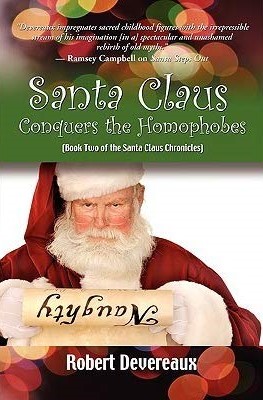 to ROBERT DEVEREAUX’S Yuletide classic SANTA STEPS OUT. In that perverse 1998 masterwork Santa Claus was seduced by the Tooth Fairy, setting in motion a series of outrages that included Mrs. Claus offering herself to Santa’s elves, the Easter Bunny turning into a horny bastard, and a woman named Rachel and her young daughter Wendy becoming involved with Santa, just as he becomes aware of his true identity as Pan, the God of debauchery. It all gets so out of hand that eventually God, a.k.a. Zeus, steps in to straighten things out by turning the Easter Bunny infertile, restricting the Tooth Fairy from Santa’s presence, and encouraging Santa to enjoy a polygamous marriage with Mrs. Claus and Rachel, with Wendy as their daughter.
to ROBERT DEVEREAUX’S Yuletide classic SANTA STEPS OUT. In that perverse 1998 masterwork Santa Claus was seduced by the Tooth Fairy, setting in motion a series of outrages that included Mrs. Claus offering herself to Santa’s elves, the Easter Bunny turning into a horny bastard, and a woman named Rachel and her young daughter Wendy becoming involved with Santa, just as he becomes aware of his true identity as Pan, the God of debauchery. It all gets so out of hand that eventually God, a.k.a. Zeus, steps in to straighten things out by turning the Easter Bunny infertile, restricting the Tooth Fairy from Santa’s presence, and encouraging Santa to enjoy a polygamous marriage with Mrs. Claus and Rachel, with Wendy as their daughter.
SANTA CLAUS CONQUERS THE HOMOPHOBES picks up several years later, with Santa and his extended family basking in the glow of the “best Christmas ever.” But Wendy, who can see into the futures of the world’s children, is upset; she’s foreseen the suicide of a gay child named Jamie Stratton due to homophobia. In an effort to cheer Wendy up Santa gets in touch with Zeus, who sends down an archangel to assist in making the Jamie Stratton’s family and friends more tolerant. Opposing their efforts is the Tooth Fairy, who dispatches a spy to keep watch on Santa in the hope that he’ll leave an opening for her to thwart his do-gooding. Just as bad if not worse is Santa’s own alter-ego Pan, who continues to torment him.
The X-rated content of SANTA STEPS OUT is largely expunged from this sequel, which also contains a none-too-subtle message about tolerance. It won me over, however, with its unfailingly imaginative narrative and lively prose. This book may be preachy, but it’s also exciting and unpredictable—and, in the manner of past Robert Devereaux novels like DEADWEIGHT and DEADOLESCENCE, utterly nuts form start to finish (did I mention nose-picking is another of the book’s major themes?).
Zombies!
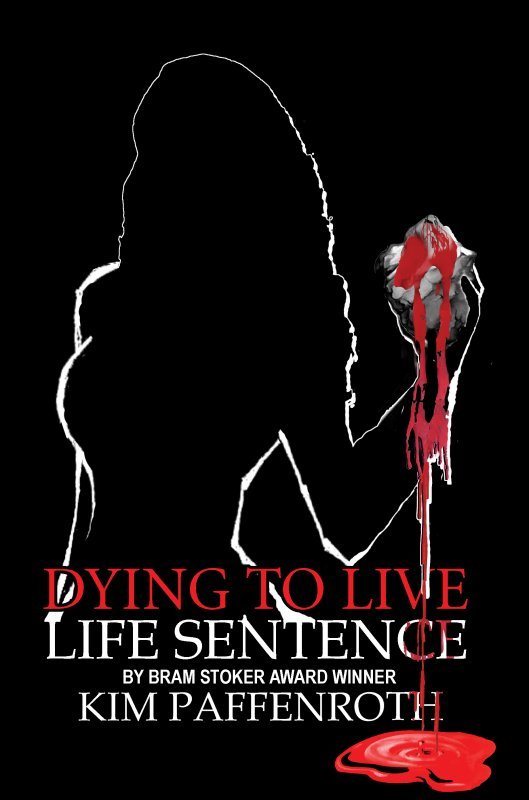 Is it just me or is every second or third horror book published these days a George Romero-inspired zombie novel? Zombies have long been a horror staple, certainly, but in recent years they’ve all-but taken over the genre. You’ll understand if I shunned the zombie apocalypse novels currently packing bookstore shelves, but I did read DYING TO LIVE: LIFE SENTENCE (Permuted Press) by KIM PAFFENROTH.
Is it just me or is every second or third horror book published these days a George Romero-inspired zombie novel? Zombies have long been a horror staple, certainly, but in recent years they’ve all-but taken over the genre. You’ll understand if I shunned the zombie apocalypse novels currently packing bookstore shelves, but I did read DYING TO LIVE: LIFE SENTENCE (Permuted Press) by KIM PAFFENROTH.
The novel is in fact a sequel to 2007’s DYING TO LIVE. I haven’t read that book but had no trouble getting into LIFE SENTENCE, as it’s a surprisingly effective novel whose subject matter was familiar to me from the films that inspired it. Yet the author has used his Romero-filched elements in thoughtful and literate fashion; there is the requisite gore and flesh gnashing, but the book’s true aims are of the philosophical variety.
The setting is a world where the living dead rule and a band of non-zombified humans subside in an abandoned museum. The two main characters are strong and compelling: there’s Zoey, an inquisitive pre-teen coming to terms with life in this nightmare world, and an “evolved” zombie who was once a university professor. In his current state the man’s memories are all-but nonexistent, forcing him to relearn everything. As his curiosity about himself and the world around him grows, this zombie finds himself rejecting the anti-social activities of his fellow deaders. In the meantime Zoey is maturing into a full-fledged zombie killer, and before long these two characters will meet—and the results, as you might guess, aren’t pretty!
The Lunch-Losers
SUCCULENT PREY is by WRATH JAMES WHITE, the current sultan of all things extreme. Initially published in a small press edition back in 2005, it’s a profoundly sick, filthy, disgusting and repellent novel—and it’s now available in mass market from Leisure, who deserves credit for having the balls to unleash this suck fuck of a book on an unsuspecting world.
True, SUCCULENT PREY is not an especially good book, but as an unflinching dive into the basest depths of depravity it works. Its “hero” is Joseph Miles, a college student who as a kid was held hostage by a deranged serial killer and now worries the psycho might have passed along a serial killer virus. Joseph becomes prone to all manner of violent compulsions, most of them involving cannibalism. He inevitably begins to act those compulsions out, devouring flesh from the ass of a gay man and then picking up Alicia, a voluptuous young sex addict, for a chowdown. Joseph falls in love with her, however, and so turns his compulsions on other less willing victims, with predictably nauseating results.
In the midst of all this Joseph decides to track down the individual who abused him all those years ago, and so takes Alicia bound and gagged with him to the Seattle nuthouse where the freak is detained…leading to more vile acts and a most unexpected revelation.
You have to admire Wrath’s knack for conjuring perverted depictions of sex and violence far beyond anything the splatterpunks of the eighties ever came up with, even if his prose is frequently trite and his vocabulary somewhat limited. He kept me eagerly turning the pages and consistently wanting to know what happened next—although rarely with any sort of pleasurable anticipation!
Another for the Extreme category is GOTH: A NOVEL OF HORROR by OTSUICHI (TOKYOPOP). 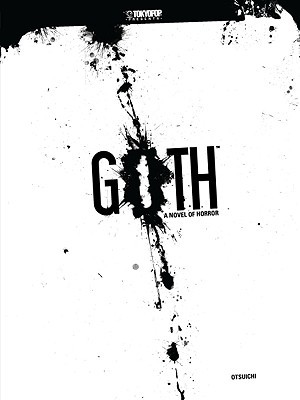 This roughie, an award-winner in its native Japan, stands out because of its construction as a collection of tenuously connected short stories, and because of its unnervingly rational, unemotional glimpse into the ugliest depths of human psychosis. The stories are connected by a creepy girl named Morino, who becomes involved in the lives of a collection of criminal psychopaths, each harboring some deranged fetish.
This roughie, an award-winner in its native Japan, stands out because of its construction as a collection of tenuously connected short stories, and because of its unnervingly rational, unemotional glimpse into the ugliest depths of human psychosis. The stories are connected by a creepy girl named Morino, who becomes involved in the lives of a collection of criminal psychopaths, each harboring some deranged fetish.
In the title story Morino and a school chum find a journal belonging to a serial killer, and use it to blackmail the psycho. “Wrist-Cut” features a disturbed school teacher with a compulsion to amputate peoples’ hands who happens to have Morino as a pupil. Morino has but a walk-on in “Dog,” about an abused girl and her brother who kill dogs in preparation for the girl’s anticipated showdown with her abuser. In “Memory/Twins” Morino attempts to deal with her sister’s horrific death. “Grave” has Morino becoming the latest victim of a freak who buries women alive, although this time the crime doesn’t quite go as planned. Finally there’s “Voice,” about Morino’s involvement with the murder of a girl and subsequent harassment of the victim’s traumatized brother.
In an apologetic afterward the author relates how GOTH came to be written and explains some of the more confusing elements. He admits that “in the real world, it’s absolutely unthinkable that so many crazy people could live in the same town,” and that his misleading moniker “was not a well-considered title.”
INFECTED is a novel by internet phenomenon SCOTT SIGLER (Crown) that, I must confess, really got under my skin. It’s the first publication from Sigler, who’s already put out several podcast-only audiobooks, this one included.
It’s a marvel of fast, inventive, up-to-the-minute pulp fiction, and also one hell of a grue-fest, with a contagion of extraterrestrial beings invading Earth through triangular infections on peoples’ bodies. The contagion is discovered and analyzed by a determined CIA operative and a CDC epidemiologist, characters who exist primarily to fill us in on the scientific properties of the triangle-things.
What gives the book its punch is the ordeal of Perry Dawsey, an ex-football star afflicted with the disease. Perry, being the irredeemable tough guy he is, is determined not to let the infections get him down, although this isn’t easy, seeing as how the things have access to their hosts’ brains.
Perry’s struggle with the triangle monsters makes for a riotously compelling story that all-but takes over the bulk of the novel, with the CIA and CDC plot threads (which aren’t nearly as interesting) pushed to the side. I won’t give too much away, as a large part of INFECTED’S enjoyment is in the unpredictability of its narrative, which branches out and mutates in a manner not unlike the disease at its core. The open-ended finale leaves the door wide open for a sequel that, FYI, appeared in late 2008: CONTAGION, which, needless to add, I’m quite anxious to read.
Good Experimental Fiction
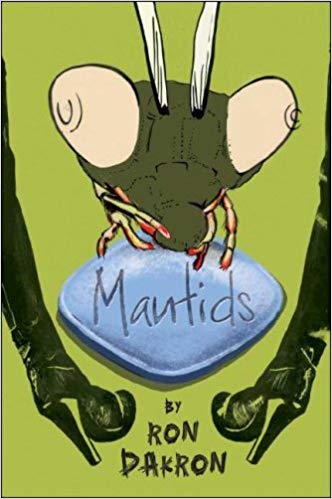 MANTIDS was a new novel by RON DAKRON (Black Heron Press), a writer I’ve grown fond of over the years. Dakron favors heavily self conscious, slip-streamy prose, yet his is among the very small cadre of experimental fiction whose substance actually matches its style. MANTIDS is the most user-friendly of Dakron’s books: it’s short and fast moving, and contains a linear narrative with a beginning, middle and end.
MANTIDS was a new novel by RON DAKRON (Black Heron Press), a writer I’ve grown fond of over the years. Dakron favors heavily self conscious, slip-streamy prose, yet his is among the very small cadre of experimental fiction whose substance actually matches its style. MANTIDS is the most user-friendly of Dakron’s books: it’s short and fast moving, and contains a linear narrative with a beginning, middle and end.
It’s set in the scuzzier regions of Astoria, Oregon, where a failed musician is afflicted with a permanent erection (having popped a bunch of Viagra tablets at once) while contending with human-sized preying mantises. Apparently there’s an alien invasion afoot that causes people to morph into cannibalistic bugs, with the protagonist one of the few remaining humans…although he’s not sure if he isn’t hallucinating the whole thing. Neither are we.
I realize not everyone will have patience with lines like “that skin husk next to the fridge, the split splattered body that her new bug self popped out of—its ripped back still oozing gray biomuck, the limbs tangled into a skin pretzel—whoa!” But the book is lively and funny, with a spot-on portrayal of the Pacific Northwest punk subculture amid all the insanity—and really: perverted sex, punk rock, Viagra, mutant insects, cannibalism, perpetual erections…what more could you possibly want?
Short Stories
JEANI RECTOR wowed me two years ago with her debut collection AFTER DARK. In ’08 she was back with a new collection, OPEN GRAVE: THE BOOK OF HORROR (Publish America), and it’s even better than the first, executed with much greater confidence and originality. Stories like “Monday Night Dive” and “Cold Spot,” with their unpredictable narratives and wildly off-kilter yet satisfying conclusions, really aren’t like anything else I can think of. More traditional, but still quite memorable, are “A Case of Lycanthropy,” about a woman who becomes afflicted with bloodlust after she’s bitten by a dog, and “The Burial,” about the coming of age of a Native American boy during a funeral ceremony.
As for standouts, I’ll have to go with “Under the House” and “Ghoul.” The first is a short and pointed exercise in apprehension, relating how an abused girl ventures into a dark area under her house and finds something truly horrible. The text of “Ghoul” is an unabridged version of a tale that appeared in truncated form in Rector’s previous book; this new “Ghoul” is a sterling example of storytelling magic, being a twisty account of a voodoo curse.
The final piece is “Open Grave,” a veritable mini-novel. It’s an imaginative portrayal of a college student under the influence of a devil-worshipping seductress named Raven. The tale is interesting in the way it inverts the classical format of like-minded stories told by a third-party observer; here we’re given an up-close-and-personal account of the cursed individual’s sufferings. But it was penned by a woman attempting to replicate a man’s point of view, and I found that quite a few details didn’t ring true. “Open Grave” also suffers from an over-baked narrative; with its relentless succession of twists within twists it’s a bit like the abovementioned “Ghoul,” but that story was told quite successfully in a fraction of the length of this one.
CONE ZERO (Megazanthus Press) is the eighth installment of the NEMONYMOUS anthology series, 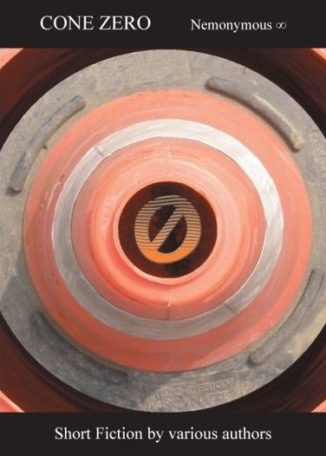 where we won’t learn who wrote what until the succeeding volume. Not having read any of the other Nemonymous anthologies, I was unsure what to expect, and it turns out that unexpected is the operative word: the stories range from horror to sci fi to who-knows-what. All, however, were conceived around the teasingly enigmatic term Cone Zero.
where we won’t learn who wrote what until the succeeding volume. Not having read any of the other Nemonymous anthologies, I was unsure what to expect, and it turns out that unexpected is the operative word: the stories range from horror to sci fi to who-knows-what. All, however, were conceived around the teasingly enigmatic term Cone Zero.
In “Cone Zero, Sphere Zero” we enter a futuristic civilization structured as a giant cone, with sinister “Enforcers” ensuring that nobody ventures beyond the cone’s summit. In “The Point of Oswald Masters” Cone Zone refers to a series of pointy installations created by a cranky artist, including one of zero height, zero diameters and zero volume—which is somehow stolen! In “To Let” the concept is more obliquely addressed, via a suspicious vase that appears to have disquieting supernatural properties.
“Always More than You Know” has a Hollywood stuntman discovering that his latest job entails far more than merely standing in onscreen for a popular action star. Another movie related tale is “Angel Zero,” a powerfully compelling mystery involving an ancient piece of film depicting a street scene in which a little girl abruptly vanishes. “The Cone Zero Ultimatum” centers on a band of sentient household appliances leaving their human master’s home in search of “Eden.” “Going Back for What Got Left Behind” is a skin-crawler about two men, both widowers, whose lives are horrifically altered after they happen upon a train platform labeled Cone Zero. “Cone Zero” is a short but resonant account of a desperate search for a woman the protagonist dreamed of years earlier. “An Oddly Quiet Street” is a wholly unpredictable haunted house tale that effectively references ROSEMARY’S BABY.
SINS OF THE SIRENS, edited by JOHN EVERSON, was the third release from Dark Arts Books, who specialize in sampler anthologies of genre fiction. SINS OF THE SIRENS contains stories by four women authors: Loren Rhoads, Maria Alexander, Mehitobel Wilson and Christa Faust, all of whom contribute solid work of an adults-only variety.
Loren Rhoads begins the book with four creepy tales grounded in aberrant psychology. In “The Angel’s Lair” a woman picks up a fallen angel in a bar–but the woman is actually a succubus looking to seduce and devour the angel. Good story, done with an eye for gritty detail and sexual explicitness. Speaking of which, “Still Life with Broken Glass”, Rhoads’s next story, is a nasty account of art snobs flavored with X-rated levels of lesbian erotica and grue. The most effective of Rhoads’ tales in my view is “Sound of Impact,” a short, sharp shocker that proceeds in ominous fashion until an underlying secret is disclosed that throws the preceding events into a new light.
Rhoads’ contributions are, it turns out, the most subtle of the entire book. Maria Alexander is next, and has a more down and dirty style. Alexander’s “Pinned” is a wild ride that mixes S&M and voodoo in eye-opening fashion; it’s one of the book’s standout entries. So too “The last Word”, in which phantom entries in a man’s diary instruct him on how to run his life—and ultimately impart some really bad advice!
Mehitobel Wilson follows, contributing for me the collection’s most powerful block of stories. “Heavy Hands” is about what happens to a guy assailed by invisible hands that act according to the desires of those around him. Creepy stuff. “Close” is even creepier: it has a voyeuristic hotel worker finding a way to insert himself into the lovemaking of a randy couple, resulting in a strong, graphic tale that concludes on just the right note of lyrical abandonment. “The Wild” tackles lycanthropy in a wholly individual manner that’s violent, sexual and poetic. Then there’s “Parting Jane”, told in the form of a journal penned by a sickly girl, whose tale represents virtually everything you’ve ever feared about doctors and/or hospitals.
The final contributions are by Christa Faust, whose three stories are grouped, appropriately enough, from good to very good to great. “Love, La Llorona” features a woman, a DVD, a murder and a satisfying twist ending. The novella-length “Firebird” centers on a deadly vampire-like machine in a gritty future world—think BLADE RUNNER meets CRONOS. Finally there’s “Tighter”, about a bondage-loving gal who finds total bliss when a guy ties her up with live ropes; it’s not until the end that she discovers what those ropes are made of. SINS OF THE SIRENS represents all that’s great about femme fiction: bloodletting, psychosis, torture and perversion!
Graphic Novels
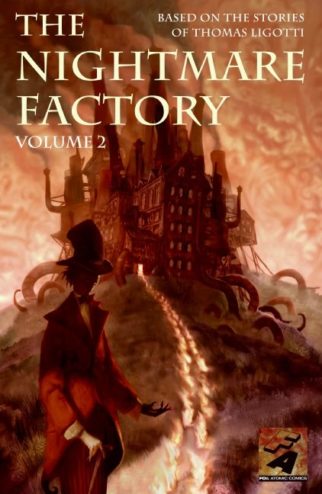 The foremost pick here as far as I’m concerned is THE NIGHTMARE FACTORY VOLUME 2 by THOMAS LIGOTTI. I really like this Fox Atomic project, consisting of graphic adaptations of stories by the inimitable Thomas Ligotti. No one else writes like this guy, who comes off like H.P. Lovecraft mixed with David Lynch. This second volume of Ligotti comics is even stronger than the first, with a greater imaginative scope and artistic range.
The foremost pick here as far as I’m concerned is THE NIGHTMARE FACTORY VOLUME 2 by THOMAS LIGOTTI. I really like this Fox Atomic project, consisting of graphic adaptations of stories by the inimitable Thomas Ligotti. No one else writes like this guy, who comes off like H.P. Lovecraft mixed with David Lynch. This second volume of Ligotti comics is even stronger than the first, with a greater imaginative scope and artistic range.
The four stories collected here commence with “Gas Station Carnivals,” adapted by Joe Harris and illustrated by Vasilis Lolos. It’s a dark tale centered on the corrosive power of memory, but with a macabre twist involving an eerie, forbidding creature. “The Clown Puppet,” adapted by Harris and illustrated in typically hallucinogenic fashion by the always fascinating Bill Sienkiewicz, follows; it’s one of Ligotti’s creepiest stories, about a spectral clown puppet with disquieting powers. “The Chymist,” adapted by Stuart Moore and visualized by Toby Cypress, is Ligotti’s darkly comedic take on the hoary old mad scientist tale. Finally there’s “The Sect of the Idiot,” adapted by Moore and illustrated by Nick Stakal, a unique account of supernatural compulsion by a Lovecraftian Thing beyond the Stars—it’s a stunner in both conception and execution. So too the volume overall, which is a must-own, pure and simple!
LOCKE AND KEY: WELCOME TO LOVECRAFT, written by JOE HILL and illustrated by GABRIEL RODRIGUEZ (IDW), is another stunner. It’s the first foray into graphic novel scripting from Hill, and a success.
The narrative layout is quite complex, and initially a mite puzzling, but the story is nonetheless a strong one: the three traumatized Locke children—Tyler, Kinsey and Bode—are taken by their mother to a rural town called Lovecraft(!). Their father, a university professor, was killed by a psychotic pupil who’s now locked away in an insane asylum. As for the house the Lockes have moved into, it’s a dark mansion filled with doors that, as six-year-old Bode quickly discovers, open into all sorts of strange alternate realities, including one that allows Bode to become a ghost. But there’s also a malevolent presence afoot: it’s the unquiet spirit of a woman looking to force her way back onto the mortal plane via an “Anywhere Key,” and is using Bode and the crazy guy who started the entire mess to affect that goal.
Hill succeeds in fully delineating the traumatic inner worlds of his youthful protagonists while never compromising the story’s forward momentum. The artwork of Gabriel Rodriguez is indispensable to LOCKE AND KEY’S impact, but this is Joe Hill’s show all the way. His evocation of surreal childhood terrors—and a few all-too-real grown-up ones—will resonate with anyone familiar with 20th CENTURY GHOSTS.
RICHARD MATHESON’S HELL HOUSE (IDW), by IAN EDGINTON and SIMON FRASER, is a 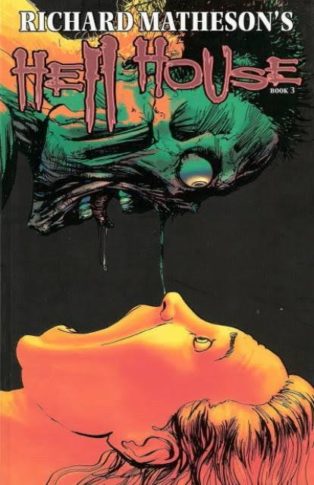 graphic novel adaptation of HELL HOUSE by Richard Matheson, originally published in 1971. Matheson, in his 1950s masterworks I AM LEGEND and THE SHRINKING MAN, laid the groundwork for the modern horror novel, and HELL HOUSE was in its own way every bit as influential.
graphic novel adaptation of HELL HOUSE by Richard Matheson, originally published in 1971. Matheson, in his 1950s masterworks I AM LEGEND and THE SHRINKING MAN, laid the groundwork for the modern horror novel, and HELL HOUSE was in its own way every bit as influential.
The premise concerns a dying man who pays a team of scientists and spiritualists to spend a week in a vast, forbidding abode known as Hell House. The place is apparently the “Mount Everest of haunted houses,” built by a depraved millionaire who created a literal Hell on Earth within.
Adaptor Ian Edginton fully retains the towering ominousness of Matheson’s novel, and Simon Fraser’s black and white illustrations likewise prove extremely memorable. Fraser has a knack for capturing partially illuminated scenes wherein much of the image is shrouded in darkness, and likes to depict his characters in the act of screaming or grimacing. Then there’s the book’s sexual content, which was unprecedented for 1971 and is still quite strong. There are episodes of sadomasochism, lesbianism, masturbation and, in the single most memorable sequence, necrophilia (wherein a woman’s erotic fantasy becomes something else altogether).
Of course all this is thrown up in the air by a final twist I’ve never been too enthusiastic about. Matheson was one of the key writers for THE TWILIGHT ZONE, and was often twist-ending happy. I’m not sure this particular story needs a twist, however, as it more than stands on its own without it.
Nonfiction
THE SPIRITUAL JOURNEY OF ALEJANDRO JODOROWSKY, published by Park Street Press, is an autobiographical volume by the incomparable ALEJANDRO JODOROWSKY, focusing on his initiation into Zen Buddhism. You can be sure the contents, incorporating hallucinations, surrealism and perverse sexuality, are very Jodorowskyian.
It begins with Jodorowsky meeting the Japanese master Ejo Taketa in Mexico during the late 1960s and becoming his disciple. The relationship lasts for years, with Taketa teaching Jodorowsky the importance of Koans, enigmatic questions posed by Zen masters for their disciples to meditate on.
The book contains a chapter about Jodorowsky’s tutelage under the surrealist painter/writer Leonora Carrington, who speaks in (seemingly) nonsensical riddles. Another covers his brief dalliance with a Mexican actress known as The Tigress, who initially befriends but inevitably turns on him. Most memorable is his recollection of his sexual courtship with the daughter of G.I. Gurdjieff, who’s mastered the art of bringing men to orgasm by contracting her vaginal muscles, and who claims Jodorowsky’s problems stem from “the pain of having a mother with a mute vagina.”
The concluding chapter consists of various anecdotes illustrating how Jodorowsky has used the teachings of his Zen masters in his day-to-day life. They include accounts on the making of EL TOPO, THE HOLY MOUNTAIN and SANTA SANGRE, as well as a brief summary of the decades-long conflict with producer Allen Klein, who withheld Jodorowsky’s early films from circulation until the two reconciled in 2004. The final page, appropriately enough, is an advertisement for Jodorowsky’s films on DVD.
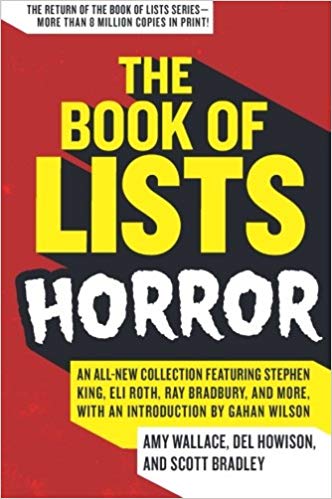 Everybody loves lists, it seems, which makes THE BOOK OF LISTS: HORROR (HARPER), compiled by AMY WALLACE, DEL HOWISON and SCOTT BRADLEY, perfect for the obsessive-compulsive categorizer in all of us. It’s an anthology composed entirely of lists, all relating to the horror field. It includes lists of the top six grossing horror movies of all time, the top ten horror-themed rock ‘n roll songs, the 20 best openings (and endings!) in horror fiction, and many more.
Everybody loves lists, it seems, which makes THE BOOK OF LISTS: HORROR (HARPER), compiled by AMY WALLACE, DEL HOWISON and SCOTT BRADLEY, perfect for the obsessive-compulsive categorizer in all of us. It’s an anthology composed entirely of lists, all relating to the horror field. It includes lists of the top six grossing horror movies of all time, the top ten horror-themed rock ‘n roll songs, the 20 best openings (and endings!) in horror fiction, and many more.
The heart of the book is the entries by writers and filmmakers who make their living from the genre. Stephen King contributes his list of the scariest horror novels and stories of all time, Jack Ketchum provides his top ten horror novels that “Don’t Call Themselves Horror Novels,” James Gunn gives us “13 Reasons God Made Humans so Squishy,” and Fangoria editor Tony Timpone reveals his least favorite Fango covers. While this is not an especially important or revelatory book, it does provide hours of enjoyment for horror buffs, who could certainly find worse ways to spend their time.
Venturing a little off topic, I feel compelled to discuss another film-related book, HOLLYWOOD UNDER SIEGE by THOMAS R. LINDLOF (The University Press of Kentucky). It’s the first truly comprehensive look at the production and reception of a film I’ve long had a compelling interest in: Martin Scorsese’s THE LAST TEMPTATION OF CHRIST, quite possibly the most controversial movie ever released by Hollywood. I have vivid memories of attending the August 1988 opening in L.A., with hordes of protestors, police and media people in attendance. This of course followed weeks of nationwide protests against the film by Christians, fanned by an extremely accommodating media.
This book, appearing 20 years later, brought all those memories back with a vengeance in its 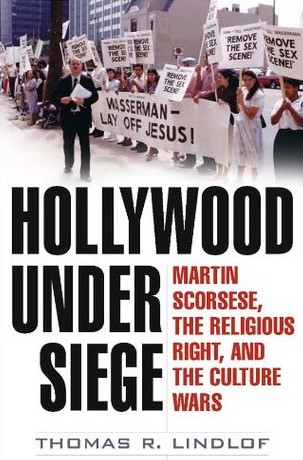 voluminously researched account of the controversy and its primary movers and shakers (which included a disgruntled religious leader initially hired by Universal to promote the film). Author Thomas Lindlof also fills us in on Scorsese’s tumultuous 15-year struggle to get THE LAST TEMPTATION made: it was initially set up at Paramount in 1983 and only ended up going into production at Universal due (among other fortuitous factors) to the wrangling of mega-agent Mike Ovitz.
voluminously researched account of the controversy and its primary movers and shakers (which included a disgruntled religious leader initially hired by Universal to promote the film). Author Thomas Lindlof also fills us in on Scorsese’s tumultuous 15-year struggle to get THE LAST TEMPTATION made: it was initially set up at Paramount in 1983 and only ended up going into production at Universal due (among other fortuitous factors) to the wrangling of mega-agent Mike Ovitz.
Neither Scorsese nor anyone else could have possibly foreseen the cultural firestorm that erupted over the film’s speculative take on the life of one Jesus Christ (most of the admonishments were from people who—surprise!—hadn’t seen the film). Even I, who paid close attention to the controversy back in ‘88, was unaware of just how insane it got until reading this book, which includes revelations of mass death threats, numerous censorship attempts by regional governments, and violent protests in European theaters screening the film. Lindlof relates all this in admirably clear-eyed fashion, and includes an epilogue on how the furor over THE LAST TEMPTATION OF CHRIST has continued to resonate over the years.
The book may not be horror-related, but it’s essential for anyone interested in controversy, censorship and how a single film can irrevocably impact an entire culture.
Reprints
The mind-blowing HIGH LIFE by MATTHEW STOKOE was first published in 2002, and got surprisingly little attention. Luckily it was brought back into print in ‘08 by Akashic Books—let’s hope it now receives the exposure it deserves!
HIGH LIFE is quite simply the most corrosive portrayal of modern-day Hollywood I’ve ever encountered, and without question the roughest. With a hero that falls somewhere between Philip Marlowe and Rupert Pupkin, a stunningly twisty narrative and some profoundly intense depictions of gore and madness, it’s a one-of-a-kind excursion in splatter-noir.
In the first of several terrific Leisure reprints, there was NIGHTWALKER by THOMAS TESSIER. In this disturbing account of lycanthropy, a young American man staying in London finds himself afflicted with a terrifying urge to kill. Originally published back in 1979, this shocker has lost none of its power over the years—it’s lean, mean and genuinely traumatizing, not to mention beautifully written by one of the genre’s most vital talents.
Another notable Leisure reprint was the 2000 anthology TRIAGE, a three-parter featuring novellas by JACK KETCHUM, EDWARD LEE and the late RICHARD LAYMON. Each author was challenged to come up with a story based on the concept of a man who enters a workplace with a gun and starts 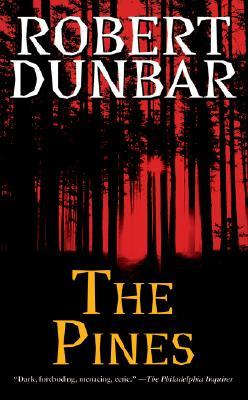 shooting. These being three of the most unflinching writers on the scene, you can bet the results in each case are plenty nasty.
shooting. These being three of the most unflinching writers on the scene, you can bet the results in each case are plenty nasty.
There was also THE PINES by ROBERT DUNBAR. This novel was initially published in heavily cut form by Leisure back in 1989. A restored edition appeared in 2006, which is the version now out in paperback—courtesy of the novel’s initial publisher Leisure. Now if that’s not poetic justice I don’t know what is!
It’s a mighty good book: tough-minded, smart and even somewhat poetic. The basis is the real-life legend of the Jersey Devil, an alleged subhuman living in the New Jersey pines who preys on normal folk. Robert Dunbar tells his wide-ranging story through the eyes of several characters, most notably those of a woman whose weird son appears to have a strange connection with something in the forest…
THE OTHER by the late THOMAS TRYON, originally published back in 1971, was one of the “Big Three” novels that changed the genre (the others were ROSEMARY’S BABY and THE EXORCIST). It’s become the most obscure of the three, although it finally saw print again in 2008, courtesy of Centipede. They put out a nifty trade paperback edition with illustrations by Harry O. Morris and a newly written introduction by Ramsey Campbell.
The story? It’s set in a rural area of Connecticut during the thirties and is centered on a kid’s twin brother, whose influence is virulent and deadly. Definitely a work of “quiet” horror, although there is a profoundly shocking surprise about two thirds of the way through.
The POD outfit Ramble House can always be counted on to dig up the wildest and most unexpected books from obscurity. In 2008 they focused on, among other authors, the work of WALTER S. MASTERMAN, a forgotten thirties-era mystery writer responsible for some of the wildest whodunits ever. In THE FLYING BEAST Masterman spins a crazed tale of a haunted house and a lost race, among other things. Action packed and furiously inventive!
I’ve long been a fan of the Fantomas books by MARCEL ALLAIN and PIERRE SOUVESTRIE, initially published in France during the early 1900’s. If you’re unfamiliar with the series you’re in luck, as in 2008 four of the Fantomas novels were reprinted, including THE EXPLOITS OF JUVE, A NEST OF SPIES and A ROYAL PRISONER from CreateSpace, and THE CORPSE THAT KILLS from Solar Books, comprising the second, third, fourth and fifth entries in the series (the first, FYI, can be found in both Penguin and Dover editions). There was also FANTOMAS IN AMERICA, a newly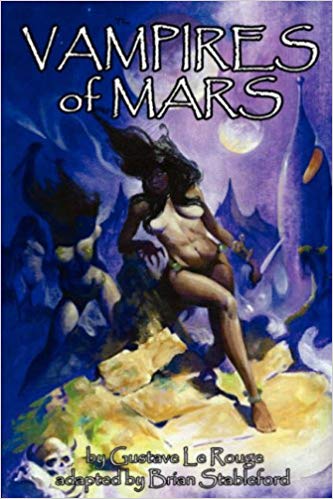 written, extremely well received continuation of the Fantomas mythos by DAVID WHITE, published by Black Coat Press.
written, extremely well received continuation of the Fantomas mythos by DAVID WHITE, published by Black Coat Press.
Speaking of Black Coat Press, I should add they also gave us an English language edition of THE VAMPIRES OF MARS by GUSTAVE LE ROUGE. Le Rouge is one of those seminal authors I’ve been hearing about for years but have never gotten a chance to actually experience, as none of his books have been translated into English. This two-part novel from 1909 is the first Le Rouge translation, and while I haven’t had a chance to read it yet, you can bet I’m looking forward to doing so. It’s about a trip to Mars that uncovers a race of vampiric creatures, and what happens when some of those critters make their way to Earth.
Looking Forward..
The coming year promises much in the way of quality horror fiction. I’m particularly looking forward to THE ADVENTURES OF MR. MAXIMILLIAN BACCHUS AND HIS TRAVELLING CIRCUS, a previously unpublished 1975 book by CLIVE BARKER; GUNPOWDER, a new novella by JOE HILL, and HORNS, a new novel; the first-ever English version of EDOGAWA RAMPO’S classic MOJU THE BLIND BEAST, the source for one of my favorite movies; HOW TO MAKE FRIENDS WITH DEMONS, by England’s brilliant GRAHAM JOYCE; JAKE’S WAKE, a new effort by the pioneering splatmeister JOHN SKIPP (in collaboration with CODY LONGFELLOW); and a new mass market edition of the unforgettable 1987 kill fest COVER by JACK KETCHUM.
Hopefully I’ll be able to cover all those books and several more this time next year, and—who knows?—maybe I’ll even be able to write about Stephen King’s 2009 publications, of which there are sure to be at least two. In short, ‘09 promises to be a jam-packed year.
